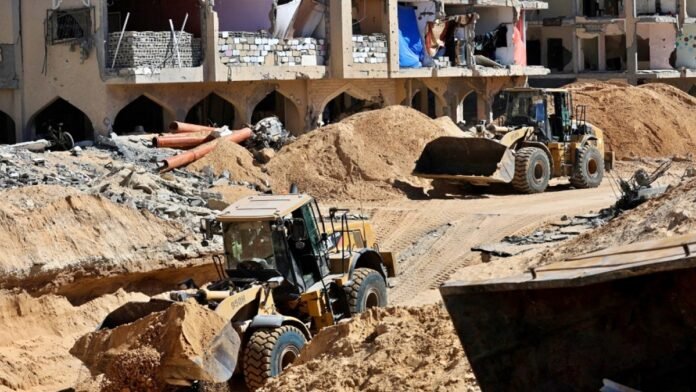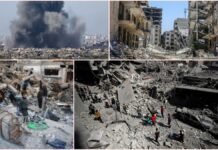
Key Points
- Hamas handed over the remains of another deceased Israeli hostage on October 27, 2025, bringing the total to 16 returned since the ceasefire began
- Twelve more bodies remain in Gaza, with Hamas claiming difficulty locating them due to widespread destruction
- Egypt deployed heavy machinery and specialist teams to assist in recovery efforts amid mounting pressure
- Israel believes Hamas knows the location of all bodies but is withholding information, violating the ceasefire agreement
- President Trump warned he is “watching very closely” and demanded Hamas resume body returns within 48 hours
- Hostage families are urging Israel to pause the ceasefire until all remains are returned
- An Israeli drone strike in Gaza killed two Palestinians hours before the latest body transfer, raising tensions
Gaza City: A significant development emerged late Monday in the fragile Gaza ceasefire when Hamas’s armed wing, the Al-Qassam Brigades, announced it would hand over the remains of another deceased Israeli hostage to the International Committee of the Red Cross at 9 p.m. local time (1800 GMT). The Israeli military confirmed receipt of the body, which was transported by Red Cross vehicles from Gaza City to Israeli forces.
This marks the 16th body returned since the U.S.-brokered ceasefire took effect on October 10, 2025. However, the process has stalled significantly in recent days, with no bodies returned in the five days before Monday’s transfer. Under the ceasefire agreement, Hamas committed to returning all 28 deceased hostages’ remains as soon as possible, while Israel agreed to return 15 Palestinian bodies for each Israeli one.
The identity of the hostage whose remains were returned on Monday has not been publicly disclosed. With 12 bodies remaining in Gaza—including 11 Israelis and one each from Thailand and Tanzania the situation has become increasingly contentious.
Challenges in Locating Remaining Bodies
Hamas has claimed significant challenges in locating the remaining 12 bodies, citing the massive destruction across Gaza as the primary obstacle. Khalil al-Hayya, Hamas’s chief negotiator in Gaza, acknowledged difficulties on Saturday, explaining that “the occupation has altered the terrain of Gaza”. He further revealed that some individuals involved in burying the bodies had been killed during the conflict, while others could not remember where the burials took place.
To address these challenges, Hamas announced on Sunday that it had expanded its search operations to new areas throughout the Gaza Strip. The Palestinian group stated it is committed to fulfilling its obligations under the ceasefire agreement and insists it is actively trying to return all remaining bodies.
Egypt’s Intervention and International Pressure
In a significant development, Egypt deployed a specialized team and heavy machinery into southern Gaza over the weekend to assist with recovery efforts. A convoy of trucks and heavy equipment, including excavators and bulldozers, entered Gaza overnight with Israeli approval, according to Egyptian officials who spoke anonymously to international media. Footage captured by Agence France-Presse showed the convoy operating in Khan Yunis in southern Gaza.
The International Committee of the Red Cross has been accompanying Hamas teams, with permission from Israeli forces, to areas beyond the designated yellow line to provide technical guidance during search operations. However, the ICRC clarified it does not participate in physically searching for or recovering remains, as this responsibility falls to the parties involved under international humanitarian law.
Israeli Accusations and Trump’s Warning
Despite Hamas’s explanations, Israel maintains that the terrorist group knows exactly where all the bodies are located and is deliberately withholding this information in direct violation of the October 9 ceasefire agreement. President Donald Trump echoed these accusations and issued a stern warning on Saturday, stating he would be “watching very closely” over the next 48 hours to ensure Hamas resumed handing over bodies.
Trump warned that Hamas would be held responsible if the ceasefire collapsed, increasing pressure on the group to accelerate the return process. The ceasefire agreement includes provisions acknowledging that Hamas may not be able to return all remains immediately, requiring the group to share any available information and “exert maximum effort” to locate the remaining hostages.
Israeli intelligence has reportedly assessed that Hamas may genuinely not be able to locate all remaining bodies immediately, though Israel continues to believe the group can and should do more. The Israeli government is reportedly considering five alternative options if Hamas fails to comply with demands to return all hostage remains.
Families’ Pressure and Political Tensions
The Hostages and Missing Families Forum issued a forceful statement urging the Israeli government, U.S. administration, and mediators not to proceed to the second stage of the ceasefire until Hamas fulfills its commitments and returns every deceased hostage to Israel. The forum stated that “Hamas knows precisely where each of the deceased hostages is located,” contradicting the group’s claims of difficulty.
The families emphasized that “two weeks have passed since the deadline set in the agreement for the return of all 48 hostages, yet 13 remain in Hamas captivity,” expressing frustration with the lack of progress. Some families have urged the government to halt the ceasefire entirely if Hamas does not successfully locate and return all bodies.
Ceasefire Violations and Security Incidents
The fragile nature of the ceasefire was underscored Monday when an Israeli drone strike in southern Gaza killed two Palestinians just hours before Hamas handed over the latest body. The strike occurred in the Nuseirat area, prompting Hamas to call it a “clear violation” of the ceasefire agreement and accuse Prime Minister Benjamin Netanyahu of attempting to sabotage Trump’s peace efforts.
Netanyahu responded at his weekly Cabinet meeting Sunday, stating, “Of course, we also thwart dangers as they are being formed, before they are carried out, as we did just yesterday in the Gaza Strip,” defending Israel’s right to act on security threats. U.S. Secretary of State Marco Rubio, who had just left Israel on Saturday, indicated that Israel, the U.S., and other mediators are sharing intelligence to disrupt potential threats, which allowed them to identify a possible impending attack over the weekend.
Israel previously targeted the same Nuseirat area on October 19 after accusing Hamas of killing two Israeli soldiers, launching dozens of strikes that killed at least 36 Palestinians, including women and children, in the most serious challenge to the ceasefire to date.
Humanitarian Crisis and Reconstruction Efforts
Beyond the hostage issue, Gaza continues to face a severe humanitarian crisis as the ceasefire enters its third week. Since October 10, the United Nations has recorded 470,000 movements of people from southern Gaza to northern Gaza as families attempt to return to their destroyed homes. However, many structures remain unstable, and unexploded ordnance poses significant risks, with at least 53 people killed by such devices.
Between Friday and Saturday alone, 300 trucks of aid were collected from the Kerem Shalom crossing, carrying thousands of pallets of wheat flour, canned food, rice, diapers, health supplies, medical equipment, medicine, tarps, tents, and winter clothes. The U.N. distributed approximately 329,000 liters of diesel on Sunday and has delivered more than one million hot meals as of that date. Fifteen U.N.-supported bakeries are now operating in Deir al Balah, Khan Younis, and Gaza City, producing thousands of loaves of bread.
Despite these efforts, families returning to Gaza still desperately need water, food, and essential services, according to U.N. Spokesperson Stephane Dujarric. Israel continues to restrict aid flow into Gaza, contrary to International Court of Justice rulings.
Multinational Coordination Framework
The ceasefire is being overseen by a U.S.-led Civil-Military Coordination Center (CMCC) based in Kiryat Gat, southern Israel, which includes military advisors from Britain, France, Jordan, and the United Arab Emirates. Around 200 U.S. troops are working alongside the Israeli military and international delegations at the coordination center, planning stabilization and reconstruction efforts for Gaza.
High-level U.S. officials have made multiple visits to the region, including Vice President JD Vance earlier last week and President Trump’s son-in-law Jared Kushner and envoy Steve Witkoff, demonstrating the administration’s commitment to maintaining the ceasefire. However, the mission faces enormous challenges due to the blockage of aid routes, ongoing security incidents, and the unprecedented scale of destruction throughout Gaza.
As the situation remains extremely fragile, the international community continues to grapple with implementing a balanced and transparent approach to maintaining the ceasefire while addressing the urgent humanitarian needs of Gaza’s population.





















































